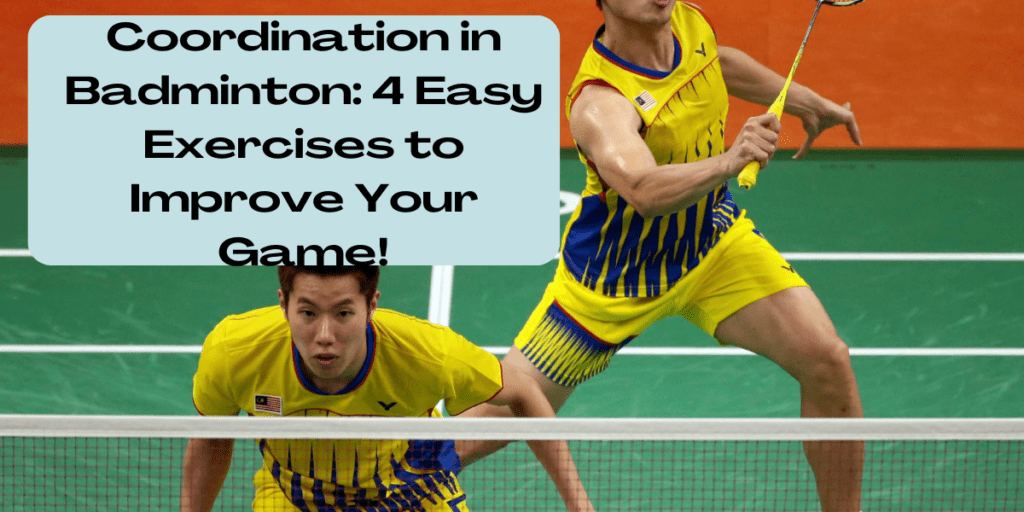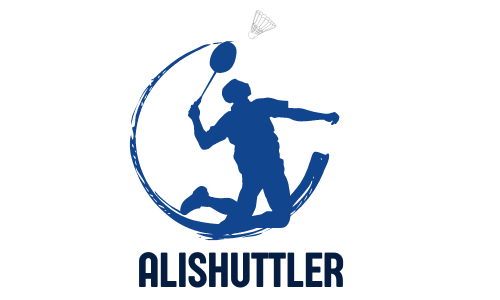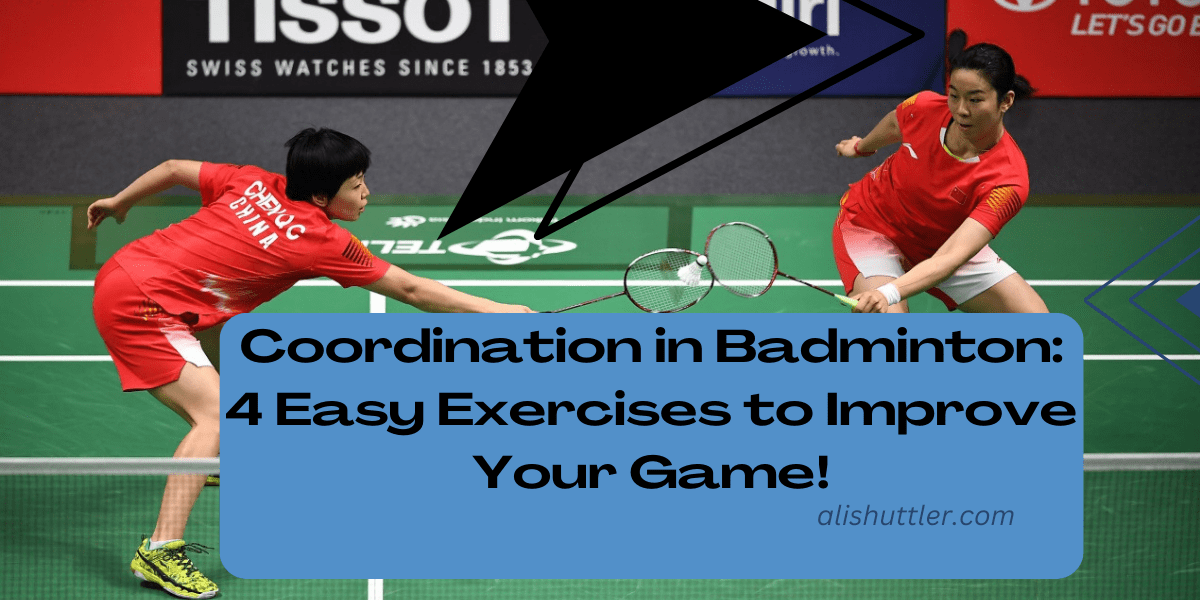Are you ready to step onto the badminton court and unleash your sports performance skills? Well, here’s a secret: coordination in badminton is the key to dominating the game. In badminton, it’s not just about swinging a racket and hitting the shuttlecock; it’s about synchronizing your entire body with agility and lightning-fast hand-eye coordination. This crucial skill allows players to execute shots with precision and efficiency, leaving their opponents in awe.
A study on sports performance found that champions excel in agility due to their exceptional coordination. These athletes react swiftly to every move, strategically positioning themselves at the front of the group. The present study, led by Principal Investigator Hyeon Bae, aims to delve deeper into this phenomenon and its impact on the performance accuracy of amateur badminton players.
So, get ready to dive into this exhilarating world of sports where coordination and balance ability reign supreme. Whether you’re a seasoned player or just starting out, understanding how coordination influences your performance on the court will undoubtedly elevate your game and improve your physical fitness. Let’s explore together how mastering this skill can make you an unstoppable force in badminton.
Table of Contents
Importance of Hand-Eye Coordination in Badminton
Hand-eye coordination is crucial in sports like badminton, as it directly affects a player’s performance on the court. Good body balance and physical fitness are also important factors to consider. Let’s explore why these skills are so vital for finger control and overall gameplay.
- Precise Shot Placement: Hand-eye coordination allows players to accurately place their shots. By tracking the shuttlecock with their eyes and coordinating their hand movements accordingly, players can hit the shuttlecock with precision, directing it exactly where they want it to go.
- Quick Reaction Time: Badminton is a fast-paced sport, and opponents’ shots can come at lightning speed. Good hand-eye coordination enables players to react swiftly and effectively to these shots. They can anticipate the trajectory of the shuttlecock based on visual cues and adjust their positioning and stroke accordingly.
- Enhanced Overall Performance: Developing strong hand-eye coordination improves a player’s overall performance on the badminton court. It helps them maintain better control over their racket, leading to more accurate smashes, clears, drops, and net shots. With improved coordination, players can execute various techniques with greater efficiency.
Tips for Developing Hand-Eye Coordination in Badminton

Practice drills that involve hitting shuttlecocks at different angles and speeds.
To improve sports performance and agility in badminton, it’s crucial to practice drills that challenge your ability to hit shuttlecocks from various angles and at different speeds. By doing so, you’ll enhance your reflexes and train your eyes to track the trajectory of the shuttlecock accurately. Here are a few examples of drills you can incorporate into your training to test your hand-eye coordination.
- For amateur badminton players looking to improve their badminton coordination and sports performance, incorporating shuttlecock target practice into their badminton training can be highly beneficial. By setting up targets at various locations on the court, players can aim to consistently hit them, enhancing their accuracy and control.
- Multi-directional hitting is a great way to improve your badminton coordination and agility during badminton training. Have a partner or coach feed shuttlecocks from different directions, forcing you to react quickly and adjust your shots accordingly. This exercise will help enhance your sports performance.
- Randomized shot placement is a great way to improve badminton coordination for amateur badminton players. Use a machine or have someone randomly feed shuttlecocks during badminton training to simulate game-like situations. This will help participants anticipate where the birdie will go.
Use visual cues to improve reaction time and accuracy.
In badminton, agility is crucial for sports performance. To improve your agility and hand coordination tests, incorporating visual cues can greatly benefit participants. Consider adding these techniques to your training routine.
- Focus on the opponent’s racket during badminton training: Pay close attention to the movements of your opponent’s racket, as it can provide valuable clues about their shot selection. This tip is especially helpful for amateur badminton players and participants looking to improve their badminton coordination.
- Watch the birdie closely during badminton training: Train yourself to keep a steady gaze on the shuttlecock throughout its flight path, improving agility and reaction time for amateur badminton players.
- Engage in juggling or follow a bouncing ball to improve hand coordination and agility. These visual tracking exercises study how well your eyes can track moving objects and test your controls.
Incorporate exercises that focus on tracking moving objects with your eyes.
Tracking moving objects not only improves hand-eye coordination but also enhances depth perception and anticipation skills. By integrating agility exercises specifically designed for this purpose into your training regimen, you can boost your overall performance in badminton. Here are some exercises worth considering for participants in the study to test their agility.
- Badminton training can be enhanced with wall ball drills. These drills improve hand coordination, agility, and can also serve as a test of skill. Throw the ball against a wall and track its movement as it bounces back towards you. Vary the speed and angle of your throws to increase the difficulty.
- In a study conducted to test hand coordination and agility, participants were asked to bat a balloon in the air. The task required them to keep the balloon aloft while also tracking its movement with their eyes. This exercise proved to be an effective way to improve hand-eye coordination and test agility.
- Badminton training: Incorporate reaction ball exercises to improve hand coordination, agility, and reflexes. Use a reaction ball that bounces unpredictably, requiring quick visual tracking. A recent study has shown the effectiveness of these exercises.
By consistently practicing hand-eye coordination drills, you’ll enhance your skills in badminton. This study shows that participants who followed these tips gained an advantage on the court. Remember, practice makes perfect!
Improve Your Footwork for Better Badminton Skills
Good footwork is important for badminton players. It helps them move fast on the court and be in better positions during the game. A study in Hong Kong showed that footwork drills are important for training. It helps with hand coordination and fitness, and it helps players learn different moves and play faster. To improve footwork, focus on the starting position and practice getting into position quickly after each shot. This will help you do better in tests and games.
One good badminton drill is hitting the shuttlecock against a wall. This helps with hand coordination and simulates real-game situations. Another useful drill is practicing serving in a target area on the court. This improves accuracy and footwork coordination. A study in Hong Kong showed that software can analyze hand coordination during badminton games, which can help players improve their footwork techniques.
Enhancing Balance: Key to Improving Badminton Game
Maintaining balance is crucial for stability during shots and movements on the court. Good balance, along with hand coordination, allows players to recover quickly after executing shots or changing directions. Regular balance training, as shown in a study, helps prevent injuries and improves overall gameplay. Testing hand coordination can also be beneficial in assessing a player’s performance.
Good balance and coordination are important in badminton. A study found that poor balance can make it hard to play well. To get better, players can do exercises to strengthen their muscles and improve balance. Another study showed that using active controls during training can improve coordination and performance. Participants who did active control exercises did better in the test.
Static and Dynamic Balance Performance in Badminton
Maintaining balance and hand coordination is crucial in badminton for optimal performance. Players need to possess both static and dynamic balance skills to excel on the court. To assess their abilities, a balance and hand coordination test can be conducted.
Balance is important in badminton. It helps players stay steady and not fall. There are two types of balance: standing still balance and moving balance. Both are important for playing well. Good balance helps players move around the court and hit the ball accurately. To get better at balance, players can do special exercises and drills.
- Static Balance:
- Standing on one leg for increasing durations
- Performing yoga poses that improve core stability
- Practicing controlled movements while maintaining an upright posture
- Dynamic Balance:
- Incorporating footwork drills that involve quick changes in direction
- Engaging in plyometric exercises like box jumps or lateral hops can help improve hand coordination for amateur badminton players.
- Agility ladder drills are a great way for amateur badminton players to test and enhance their coordination and foot speed.
To do well in badminton, players need to practice their balance and coordination. This helps them move quickly and stay steady during the game.
Simple Exercises for Badminton Coordination Training
Incorporate ladder drills into your training routine to improve footwork coordination. These drills involve stepping in and out of ladder rungs quickly, which helps to enhance agility, balance, and coordination on the badminton court.
Try juggling exercises to enhance hand-eye coordination outside of badminton practice sessions. Juggling not only improves your ability to track moving objects but also strengthens the connection between your eyes and hands. You can start with two balls and gradually work your way up to more challenging juggling patterns.
Balance board exercises can help develop stability, core strength, and overall coordination. By standing on a balance board or wobble board, you challenge your body’s ability to maintain balance while performing various movements. This directly translates to better control and coordination during badminton matches.
To further improve coordination in badminton, consider incorporating these exercises into your training regimen:
- Shuttle Run: Set up two markers approximately 10 meters apart for amateur badminton players. Start at one marker and sprint back and forth as quickly as possible while touching each marker with one hand.
- Reaction Ball Drills for Badminton Players: Use a reaction ball to improve hand coordination. The reaction ball bounces unpredictably when thrown against a wall or floor. React quickly by catching or hitting the ball with different parts of your racket.
- Shadow Footwork: Mimic the footwork patterns used in badminton without a shuttlecock. Focus on quick changes of direction, explosive movements, and maintaining proper form.
By regularly practicing these exercises along with your usual badminton training, you’ll notice significant improvements in your overall coordination on the court. So, grab a ladder, some juggling balls, and a balance board – it’s time to take your badminton skills to the next level!
Tennis Ball Drills to Improve Hand-Eye Coordination
Practice hitting a tennis ball against a wall to improve timing and accuracy. This simple drill is effective in honing hand-eye coordination in badminton. Stand a few feet away from the wall and hit the tennis ball with your racket, aiming for specific targets on the wall. This exercise helps you develop better control over your shots and enhances your ability to anticipate the trajectory of the ball.
Use a tennis ball machine for varied shot placements and speeds, perfect for badminton players.
Incorporate catching and throwing exercises with a tennis ball to enhance hand-eye coordination. Catching and throwing drills not only improve your hand coordination but also help you develop the quick reflexes necessary for badminton rallies. Start by tossing the tennis ball up in the air and catching it repeatedly using one hand or both hands. As you progress, increase the difficulty by incorporating movement or performing these exercises while standing on one leg.

By integrating these tennis ball drills into your training routine, you can significantly boost your hand-eye coordination for badminton. Remember that consistent practice is key to improving this essential skill in sports like badminton.
- Practice hitting a tennis ball against a wall
- Use a tennis ball machine for varied shot placements and speeds
Mastering One-Leg Balance: Crucial Skill for Badminton
Enhancing coordination in badminton requires mastering one-leg balance, a crucial skill that improves stability and control on the court. By practicing specific exercises to enhance leg standing balance, players can significantly enhance their performance in this dynamic sport.
One-leg balance exercises are particularly beneficial for shots that require weight transfer. When executing powerful smashes or precise drop shots, players need to shift their weight from one leg to another. By improving one-leg balance, players can maintain stability during these weight transfers, resulting in more accurate and controlled shots.
Mastering one-leg balance helps players control their movements during quick changes of direction in badminton. It improves agility and allows players to move around the court easily. Regular practice of one-leg balance drills is important for coordination, strength, flexibility, and body awareness. A study by Kuo Wang showed that players with good leg balance had better coordination than those with weaker balancing skills.
The Role of Proper Training and Equipment in Badminton Success
Quality training programs tailored to improving coordination are essential for success. By focusing on specific exercises and drills that target coordination, badminton players can enhance their overall performance on the court. Incorporating aerobic training into fitness routines can also improve endurance, allowing players to maintain accuracy and ability throughout a match.
Using appropriate equipment is equally important for optimizing badminton performance. Lightweight rackets enable players to maneuver swiftly and strike with precision, while shuttlecocks designed for speed and stability ensure consistent gameplay. Supportive shoes provide the necessary grip and cushioning to prevent injury and enhance agility.
A combination of proper training techniques and suitable equipment maximizes coordination development in badminton players. When amateur badminton players invest time in quality training programs that focus on coordination improvement, paired with the right equipment choices, they can significantly elevate their sports performance.
Impact of Coordination in Badminton Performance
Good coordination in badminton has a significant impact on players’ performance. It not only enhances shot accuracy but also improves speed and reaction time, resulting in better outcomes on the court. Here’s how coordination affects badminton players:
- Shot Accuracy: Players with good coordination have better control over their shots, allowing them to place the shuttlecock precisely where they want it to go. This accuracy increases their chances of scoring points and outmaneuvering opponents.
- Speed: Coordination plays a crucial role in executing the quick movements required in badminton. Well-coordinated players can swiftly change direction, accelerate, and decelerate, giving them an edge over less coordinated opponent. Their ability to cover the court efficiently allows them to reach shots that others might miss.
- Reaction Time: In fast-paced games like badminton, split-second reactions are essential. Improved coordination enables players to react quickly to their opponent’s shots or anticipate their moves accurately. This heightened reaction time helps them stay one step ahead and make timely decisions during intense rallies.
- Complex Shot Execution: Badminton involves various types of shots such as smashes, drops, clears, and drives. These shots require precise coordination between footwork, body positioning, grip technique, and racket swing. Players with superior coordination can execute these complex shots with ease and finesse.
Having superior coordination gives badminton players a competitive advantage over their opponents. It allows them to perform at their best by enhancing shot accuracy, speed, reaction time, and the ability to execute complex shots effortlessly. By focusing on developing coordination skills alongside technical proficiency and strategic gameplay knowledge, players can elevate their performance on the badminton court.
Remember: Practice is key when it comes to improving coordination in badminton!
Key Takeaways on Coordination in Badminton
In conclusion, coordination plays a crucial role in badminton performance. The ability to synchronize hand-eye movements, develop footwork skills, and maintain balance greatly impacts your overall game. By focusing on these aspects and incorporating specific exercises into your training routine, you can enhance your coordination abilities and elevate your badminton skills.
To be good at badminton, you need to practice your hand-eye coordination with a tennis ball. You should also work on your footwork and balance by practicing how to move around the court and standing on one leg. It’s important to get proper training and use good equipment, like getting help from a coach and using gear that fits your style of play. By focusing on these things, you will become a better badminton player. So, start using these tips today to improve in badminton and be successful on the court!
FAQs
Q: How long does it take to improve coordination in badminton?
The time required for badminton players to improve coordination varies depending on factors such as dedication, practice frequency, natural aptitude, and starting skill level. Consistent practice over several months can lead to noticeable improvements for badminton players.
Q: Are there any specific exercises to improve hand-eye coordination in badminton?
A: Yes, there are various exercises you can incorporate into your training routine. Tennis ball drills, reaction ball exercises, and shadow badminton are a few examples that can enhance hand-eye coordination.
Q: Can coordination be developed at any age?
A: Absolutely! While it may be easier for badminton players to develop coordination skills due to their experience and practice, coordination can still be improved at any age with consistent practice and targeted training.
Q: Is balance important in badminton?
A: Yes, balance is crucial in badminton as it allows players to move quickly and maintain stability during rallies. Developing both static and dynamic balance through specific exercises will greatly benefit your overall game.
Q: How can I find the right equipment for my badminton game?
A: To find the right equipment, consider factors such as you’re playing style, skill level, and personal preferences. Seeking advice from experienced players or consulting with professionals at sports stores can help you make informed decisions.

